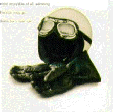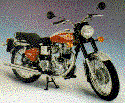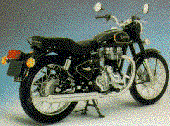The history of the Royal Enfield Bullet
By Ian Chadwick, former (Royal) Enfield Bullet 500 rider,
Collingwood, Ontario, Canada. Last updated: May 24, 2003
 NOTE: This brief history is cobbled from different sources, so it is far
from complete and may contain inaccuracies for which I apologize in advance.
If you have other knowledge that can improve this page, or can recommend
good source material to me, please send email at the address below. Thanks.
NOTE: This brief history is cobbled from different sources, so it is far
from complete and may contain inaccuracies for which I apologize in advance.
If you have other knowledge that can improve this page, or can recommend
good source material to me, please send email at the address below. Thanks.
The grandfather of the Bullet was first produced by Royal Enfield in 1931: a four-valve, single-cylinder was introduced, given the name 'Bullet' in 1932. It had an inclined engine and an exposed valve gear. The 1935 G model was the first that assumed the 'modern' look, with vertical cylinder, cast-in pushrod tunnel and eventually fully enclosed valve gear. It had a gear-driven magneto and double-ended eccentric oil pump. Over the next few years the single would sport two, three and four-valve cylinder heads.
In 1948: The first 350 Bullet Roadster was introduced. Although it was similar in many ways to the 1935 G model Bullet, it was a new motorcycle with many design innovations. It was the first British production bike with a rear swing arm. It also had an oil filter (with integral oil tank in the crankcase behind the crank) and alloy primary chain case. It was a two-valve pushrod design in semi-unit style, with gearbox bolted to crankcase. Rubber kneepads were on the gas tank. It had four gears (one up, three down like most British bikes of that era - apparently Triumph was the oddity with high gears up). A Trials/Scrambler model was also introduced.
1949 The sports model had
an unsprung front mudguard.

1951: Modifications include smaller front mudguard and silencer, alloy speedometer nacelle and modified fork ends.
1952: A crankcase breather was fitted, plus a sidestand. Trials model gets alloy barrel. Apparently only 16 350 Bullets made this year. A prototype 500cc model is shown in an industry motorcycle show.
1953: The 500cc Roadster model is
introduced. The 350cc was upgraded to include changes designed for the
500cc: improved bottom end with four main bearings, improved lubrication
system, modified frame, larger rear brake, single pilot light under headlamp.
1954: A new casquette (nacelle with speedometer, headlight and twin side lights) replaces headlamp bracket. The exhaust angle and rear spring and shock are changed. The 350 got a frame lug change. Armstrong units were adopted for suspension, giving 50 per cent more movement.
1955: Camshaft upgrade. The concentric kickstart and gear change lever on the gearbox, plus the air filter are changed. The front brake gets a twin, full width hub, brake. The 350 gets a monobloc carb. The bench (dual) seat is now standard, although the single sprung saddle seat was still available.
Around this time, the 500cc Bullet was also sold in America as the Indian "Woodsman."
 In
1955, the Indian government needed a solid and reliable motorcycle for
its police and army, in particular to patrol the rugged border highways.
The Bullet was chosen as the most suitable bike for the job. The Indian
government ordered 800 of the 350cc model, beyond the company's ability
to fill at the time. With more orders from India looming, the company
sold its design to Enfield India, a subsidiary firm in Madras, India to
start manufacturing them there.
In
1955, the Indian government needed a solid and reliable motorcycle for
its police and army, in particular to patrol the rugged border highways.
The Bullet was chosen as the most suitable bike for the job. The Indian
government ordered 800 of the 350cc model, beyond the company's ability
to fill at the time. With more orders from India looming, the company
sold its design to Enfield India, a subsidiary firm in Madras, India to
start manufacturing them there.
There was some retooling and redesign done at the English plant (Redditch) in 1955 to modernize the Bullet (including changes in the gear ratios in 1959).
Between 1956 and 1960, the Bullet was released in several models, including a 350cc Trials "works replica" version, and a 350cc "Clipper" model. Technically the engines and power trains were the same (except for bore size) and the only differences were in exhaust, seating, instrumentation, handlebars and gas tank. A lot of technical improvements were also made in that time, including moving to alternator charging (1956) and coil ignition (1960). The 350cc model continued in production, but the 500cc model was dropped in 1961. An "Airflow" model was also made briefly, with a fairing.
1956: Both models underwent several
improvements: a new frame and air filter housing, battery/toolkit box.
The engine got a wider floating big-end bush and cylinders head changes
(separate rocker boxes retained) and stronger bottom end. The 500 got
a monobloc carb, alternator for charging and folding kickstart. A new
dual seat is introduced. The modern Indian Enfield uses the post-56 engine
(with metric bearing sizes), although it uses the earlier frame.
1956 saw an all-welded, brazed-lug frame introduced, and also sent to India.
1957: Quick-detach rear wheel was introduced as an option. The air filter was enlarged. The 350 gets an alternator. The Bullet is now fully manufactured in India under licence, at Anna Salal, near Madras. The tooling equipment was also sold to make the 350cc Bullet in India in 1958. Later the Indian firm upgraded to make the 500cc model as well. (One printed source says tooling for both models was sold to India in 1967 - but most agree it was 1957.) By this time the English company was under different ownership and that year they closed the Redditch factory where Bullets had been made, so it's possible the remaining tooling equipment was sold to Madras at that time, but they certainly had manufacturing equipment in India a decade earlier.
 One
source, Peter Sanidal, says that there were "Moto Cross" (MX) bullets made
in this period. The 350 had a cast aluminum head, and the 500 an iron
barrel. Apparently two 350s, and two 500s were imported into Vancouver
by Frank Carr in 1957. Carr succumbed to cancer shortly after they arrived,
and his business stood down at that time. All the MX bullets that came
into Vancouver for '57 had Lucas Magdynos on them. They also were equipped
with quick-detachable lights and number plates on the rear frame, plus
high straight pipes as well. They were very fast bikes. The 350 would
blow away just about anything on the street up to 70 mph or so. He says
they were essentially the bikes he saw advertised in cycle magazines of
the time as the Indian Woodsman and Warrior - competition models.
One
source, Peter Sanidal, says that there were "Moto Cross" (MX) bullets made
in this period. The 350 had a cast aluminum head, and the 500 an iron
barrel. Apparently two 350s, and two 500s were imported into Vancouver
by Frank Carr in 1957. Carr succumbed to cancer shortly after they arrived,
and his business stood down at that time. All the MX bullets that came
into Vancouver for '57 had Lucas Magdynos on them. They also were equipped
with quick-detachable lights and number plates on the rear frame, plus
high straight pipes as well. They were very fast bikes. The 350 would
blow away just about anything on the street up to 70 mph or so. He says
they were essentially the bikes he saw advertised in cycle magazines of
the time as the Indian Woodsman and Warrior - competition models.
"They were very fast bikes," Snidal writes. "The 350 would blow away just about anything on the street up to 70,mph or so. In fact, I not only saw the original owner of one of them do it to just about all of us, at one time or another, including a 500 Velo Venom, which was the 2nd fastest (after that day) in our little pack, but also 350 Vipers, (both of them) and everything else it came up agains. A few years later, I got ahold of it, and rebuilt/restored it, and once again blew away TR6's with impunity. It had very radical cams (straight up, open a long time, straight down - the ramps were so steep is looked like they'd just jam the cam followers - and the 350's came with a 15:1 (yes!) piston. (You could buy real gas in those days)."
1959: Smaller 17-inch wheels. Coil ignition. Optional Airflow fairing with deeper front mudguard. Forks modified. Oval oil pump cover plates on 500. 350 gets larger, re-shaped 3.75-gallon gas tank, chain enclosure and larger, wider seven-inch front brake (the 500 retained its six-inch twin drum brake). New stylish gas tank (also used by Enfield's export twins) Trials model gets heavier flywheels, and exhaust is tucked away, but continues with magneto.
1960: Huge, one-piece alloy cylinder head ('Big Head') casting, plus new, larger 'chunky' tank for 500. This is also the engine design used for the India Enfield Bullet. Coil ignition is introduced.
The Royal Enfield Fury, produced at this
time for the US market, is essentially the same bike as the Bullet (both
350 and 500cc models), capable of reaching the 100 mph mark (a 350cc Enfield
tuned by Steve Lindsell in the late 1970s reached 95.64 mph) . It differed
from the Bullet by having a larger inlet port, an Alfin aluminum alloy
barrel with cast liner (instead of the Bullet's iron) and a higher compression
piston (8.9:1 instead of 7.3:1). It also had a flange for mounting an
optional rev counter, an 18-inch rear and 19-inch front wheel. Between
1959 and 1963, only 191 machines were made. The 500cc boasted a 40 bhp
output, up from the UK models' production of 27 bhp. A 600cc model was
also made for a short period.

1961: Detachable end-cap fishtail silencer. Trials model discontinued except by special order.
1962: Deeper rear mudguard. Both
350 and 500 models discontinued. The UK company was sold in 1962 and the
Bullet line discontinued.

Enfield India continued to churn out Bullets just the way they were made in England in 1955. Forty years later they still do, with a few minor modifications (signal lights, a 28 mm Mikuni carb, 12-volt electrics, a better bench seat and in 1990, twin leading-shoe brakes). While not the largest motorcycle manufacturer in India (they rank about third, producing around 18,500 bikes a year but have plans to increase that to 25,000), they are one of its oldest.
Initial attempts to import 350 Bullets into
the UK in the 1970s (by the Slater Brothers and later Evesham Motorcycles
- according to one source the actual date of the first re-introduction
was 1977), were unsuccessful. The bike wasn't up to par and the exchange
rate wasn't very good, so they were not as inexpensive as they are today.
The Indian company had little interest in making changes the few sales
exports could garner.

In 1986, Raja Narayan, a UK civil servant, returned to his home in India and started an export arm for the company to bring the Bullet back into England. He got his first 350 into England that year. He was responsible for many of the production changes that improved sales and quality over the years. It was the prodigal son returning home. The bike appeared in UK motorcycle shows in 1989 and at the Classic Bike Show in Stafford in 1990. Canada started importing them three years ago, and the US in 1995. Twenty countries now import them.
In late 1995, the Indian firm finally
acquired the name Royal Enfield as their own. The Canadian importer started
putting the new decals on the tank in early 1996. The address and contact
for the manufacturer is:
Attn: Mr. G. Shankar, Exports
Post Box no. 5284
Thiruvottiyur, Madras
India
600 019
Recently, Swiss engineer Fritz Egli has
been working with Enfield to improve production for export models. He
also designed performance improvements for his own retail sales Bullets
(his models push 26bhp rather than the stock 22) and has been discussing
a five-speed transmission with the company. He designed a 535cc version
which produces 45bhp and a 624cc racer (47.5 bhp) with a top speed of
160 kph (100 mph). Neither one has made it to North America... yet.
A few tech specs for the 500cc: four
stroke, OHV (two valve pushrod);
bore & stroke: 84mm x 90mm;
compression ratio: 6.5:1;
output & torque: 22BPH @ 5,400 rpm, 3.5 kgm/3,000 rpm;
12 volts, battery & coil, dry sump lubrication, positive plunger type;
clutch: multiple, oil immersed;
four speed constant mesh transmission, one down 3 up with neutral finder;
brakes: twin lead, drum 7 in., rear drum 6 in.;
tires: front 3.25 x 19 in. ,rear 3.5 x 19 in.;
fuel consumption: 70 mpg or 25 km/ltr; size (l/w/b): 82.25 x 27.25 x 41.5
in. (2,110 x 700 x 1,067mm);
wheelbase: 53.5 in. (1,372mm);
 ground clearance: 5.5 in. (140mm);
ground clearance: 5.5 in. (140mm);
seat height: 30 in. (760mm);
dry weight: 168 kgs;
max speed: 125 kmph (the speedo is mildly inaccurate, and this may be
closer to 110 kmph).
My thanks to Terry Smith and Don Detlor
of T&D Impex for their patience, understanding and unhesitating support.
Since this review was written, circumstances required that me to sell my
Bullet and T&D Impex has closed. Several years have passed and I am again trying to find one.
Please contact me if you have one for sale.
Ian Chadwick.
Thanks to John Woodgate and Terry Smith for some of these pictures.
Comments, changes and questions welcome: please post them on my forum.
Cruising on two wheels along the Information Highway!